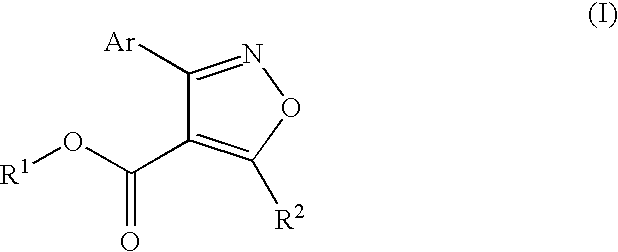Process for preparing isoxazole compounds
a technology of isoxazole and compound, applied in the field of process for preparing isoxazole compounds, can solve the problems of multiple steps in the process and potentially expensive reagents, and achieve the effect of simple and more economical
- Summary
- Abstract
- Description
- Claims
- Application Information
AI Technical Summary
Benefits of technology
Problems solved by technology
Method used
Image
Examples
example 1
Ethyl 5-methyl-3-phenylisoxazole-4-carboxylate
[0026]To a 100-mL three-necked round-bottom flask fitted with stopper, a nitrogen purged inlet for a small diameter tube, and a gas outlet adaptor connected to a mineral oil bubbler is added sodium ethyl acetoacetate (Aldrich) (2.93 g, 19.8 mmol), dimethylsulfoxide (15 mL), and triethylamine (6 mL, 47.2 mmol). A slow nitrogen gas flow is started through the reactor. The mixture is stirred until the solid dissolves. A solution of phenylnitromethane (2.7 mL, 19.8 mmol), ethyl chloroformate (1.89 mL, 19.8 mmol) and tetrahydrofuran (5 mL) is prepared and added to a syringe attached to a syringe pump connected to the reactor using small bore tubing. This solution is then added to the reactor at a rate of 7 mL / hour with magnetic stirring of the reactor contents. After the addition is complete a sample is withdrawn, neutralized with excess 1N HCl (aq.), extracted with methylene chloride, and analyzed by gas chromatography. One major component i...
example 2
Ethyl 5-methyl-3-phenylisoxazole-4-carboxylate
[0027]In a similar reaction as Example 1, the product is isolated by neutralization with excess 1N HCl(aq.) followed by extraction with methylene chloride and solvent removal. The resultant material is purified by column chromatography on silica gel using methylene chloride as eluting solvent. The product is then analyzed by NMR to confirm its identity. H-NMR (CDCl3) 8.0-7.0 (m, 5H), 4.1 (q, 2H), 2.7 (s, 3H), 1.2 (t, 3H). Additionally the reaction mixture is analyzed by high resolution GC-MS to confirm the molecular formula of the product formed. The major component has a formula of C13H13NO3 and a molecular weight of 231.09 g / mole consistent with ethyl 5-methyl-3-phenylisoxazole-4-carboxylate.
PUM
| Property | Measurement | Unit |
|---|---|---|
| reaction time | aaaaa | aaaaa |
| mole ratio | aaaaa | aaaaa |
| temperature | aaaaa | aaaaa |
Abstract
Description
Claims
Application Information
 Login to View More
Login to View More - R&D
- Intellectual Property
- Life Sciences
- Materials
- Tech Scout
- Unparalleled Data Quality
- Higher Quality Content
- 60% Fewer Hallucinations
Browse by: Latest US Patents, China's latest patents, Technical Efficacy Thesaurus, Application Domain, Technology Topic, Popular Technical Reports.
© 2025 PatSnap. All rights reserved.Legal|Privacy policy|Modern Slavery Act Transparency Statement|Sitemap|About US| Contact US: help@patsnap.com



